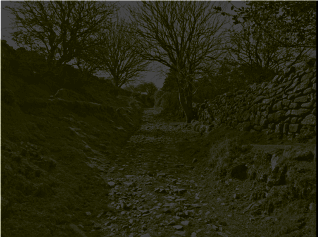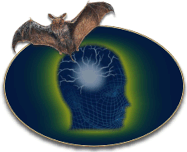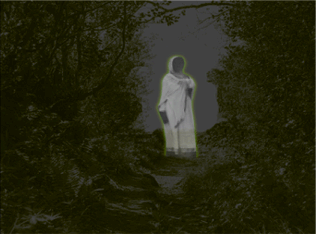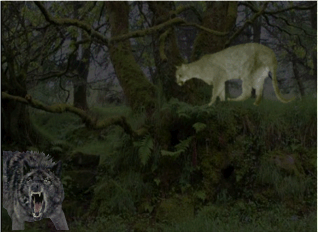
This week (Jan 2009) I had to travel across Dartmoor at night in driving rain and a dense fog that brought visibility down to about 10 feet. It was no real problem as I know the road from Ashburton to Two Bridges well, but it got me thinking, “what would it be like to make the same journey in olden times?” Where the perils and fears of a lone traveller the same as they are today? To answer this it would be as well as to determine what physical dangers and psychological fears one may experience today if such a journey was to be made on foot in the dark.
The physical dangers on such a night would be getting lost, tripping up in a pothole, the risk of hyperthermia, being hit by a vehicle, slipping up in mud or ice or maybe being attacked. Thanks to modern day inventions many of these perils have been minimised; road signs, GPS and maps now guide us to our destination, outdoor clothing gives us protection against most weather conditions whilst high intensity torches provide an excellent light source to see where you’re going. High visibility reflective clothing helps us stand out in the dark and normally at all times a mobile phone gives us access to the emergency services.
Now imagine the same journey in times gone by, there would be no road as such just a trackway which at night would look at best something like this:

Naturally people would try to avoid travelling across or around the moor in the darkness wherever possible but there would have been occasions where it would have been necessary. For instance; farmers returning home after taking stock and produce to market, labourers such as miners, quarrymen etc travelling back home after a days work, travellers and journeymen taking packhorse loads across the moor, in early times monks going between the various monasteries, drovers and stockmen moving their animals around the moor etc, etc. It was not until the mid 1700s that there was anything that vaguely resembled a road on Dartmoor so all of the journeys would be made along trackways, paths and trans-moorland routes. In the 1640s Tristram Risdon noted the following about Devon roads:
‘painful for man and horse, as they can best witness, who have made trial thereof. For be they never so well mounted upon horses out of other countries, when they have travelled one journey in these parts, they can, in respect of ease of travel, forebear a second.’, Risdon, 1970, p.iii.
Things had not improved by the early 1800s as is apparent from Vancouver’s remarks:
‘The height of the hedge-banks, often covered with a rank growth of coppice-wood, uniting and interlocking with each other over-head, completes the idea of exploring a labyrinth rather than that of passing through a much frequented country… In these lanes it is absolutely impossible to form any idea of the surrounding country, as the size and depth of the abutting fields are only to be seen through a breach in the mound… As there are but few wheel-carriages to pass along them, the channel for the water, and the path for the pack-horse, are equally in the middle of the way, and which is altogether occupied by an assemblage of such large and loose stones…‘, Vancouver, 1969, p. 368.
It is worth remembering that these dark journeys were taking place right up until recent times so this was not only an occurrence which took place in times of yore.
Firstly the only light sources available would be a flickering lantern or maybe some moonlight. There was always the danger with early lanterns of the candle blowing out, if this happened it was not always easy to relight it, especially in wet and windy conditions. If the mist was down then the visibility afforded by the dim lantern would be reduced drastically.
The track would be strewn with loose rocks and boulders on which it would be easy to twist an ankle of fall over. The floor of the track would be muddy and if it was raining probably there would be small rivulets running down it or water filled puddles. Again, very easy to slip on the mud or stumble into a pothole making it embarrassing at best dangerous at worst. Many of the tracks would be lined with trees whose branches meet thus creating a dark canopy, in windy conditions there would be the danger of falling boughs.
There were no maps or road signs so unless the traveller knew the route navigation was difficult and when the mist was down nearly impossible. At best there may have been an old granite wayside cross that would give some indication that the traveller was on the right path as well as providing some divine reassurance. Should they become lost in the remoter areas of the moor then their would be no human help to put them back on the right path.
In wet, cold, and windy weather the clothing of the time gave very little protection. At most the early traveller would have a thick woollen cape or coat and possibly leather boots or shoes all of which were not very waterproof. In later years the standard of weatherproof clothing did improve but not to such an extent as to be waterproof. Any poor soul out on such a night would soon become wet, cold, tired and miserable with the very real threat of becoming hypothermic. Indeed, many travellers have died from exposure whilst being out on the moor at night, especially in winter time, see – HERE.
Should any wayfarer become injured in any way the only chance of getting assistance was from a nearby cott or farmstead should there be one. If there wasn’t then they were very much on their own.
All night travellers faced the risk of being robbed by thieves, especially the local folk returning from market. It was a well know fact that they had probably sold livestock or produce and were carrying money with them, see HERE. A very poignant reminder that such criminals were at large was the gibbet from which the corpses of convicted thieves and robbers hung, one example being at Gibbet Hill – see HERE.
Another very real threat for travellers prior to the 1700s was that of wolves who at the time stalked the moor in search of food – see HERE.
Other obstacles enroute were the numerous shafts and pits that dotted the moor in tin mining areas, indeed a report in The Times newspaper of 1811 tells of how a man fell down a shaft and stayed there all night until rescue came the following day. Many of the moorland tracks ran across streams and rivers which were crossed by way of either a clapper bridge or a ford. When the waters were high this could often mean a dangerous crossing or a long detour, there have been instances where the heavy granite spans have been washed away by the force of the water. In wet or icy conditions these granite bridges would become slippy thus providing the risk of a fall or even a soaking – see HERE.
For those fortunate enough to have a horse or pony to ride some of the previous perils would be somewhat lessened. However, there was always the danger of the mount being spooked or stumbling which could well end up with the rider being thrown from the saddle. This in itself could cause injury or death where again help was not easy to find.

So having looked at some of the physical perils and fears that darkness brought upon the Dartmoor traveller of both then and now what are/were the psychological fears? Clearly this is a difficult subject to address because everyone has a different set of beliefs, phobias and perceptions. It could be argued that today these would be based on a more logical basis than they would have been nine hundred years ago. Over the years science has given us a greater understanding of natural events that at one time would have struck fear deep into the hearts of people. For instance we now know what causes the formation of a rainbow, what a shooting star is, how thunder and lightening are caused, what an eclipse is etc, etc. But to a lone traveller in the dark a thunderstorm must have been a scary event as would a thick moorland mist rolling down from the high tors.
Possibly the greatest contributor towards a fear of the dark is one’s own imagination because this can turn reality into a perceived threat or fear. For instance, it is a well known fact that a dense Dartmoor mist can make objects appear much larger than they are. So, to somebody who is susceptible to supernatural beliefs a sheep may be perceived, with the help of the mist and one’s imagination, as being some huge, terrifying monster who is waiting to devour one’s flesh. There is a well known folk tale of Pixie’s Cross which is a splendid example of such a perception – see HERE. Compounding the fears that imagination can bring are the religious beliefs and local superstitions of the time. In medieval times the church was instilling a dreaded fear of the Devil, damnation and evil spirits into its congregations. Witchcraft, see – HERE, was another very real threat at the time as was ghosts, see – HERE, piskies, – see HERE, curses, see – HERE, spells and a whole gamut of supernatural beings. Therefore at that time imagine what fear and dread lived in the hearts and minds of travellers in the darkness, when behind every rock and tree could lurk any kind of unspeakable evil. Not only would people be in fear of their lives but also their souls and health, a whole army of things were at large who could haunt, possess, curse, injure or even kill. Imagine walking along a moorland track and being faced with the scenario picture below:

This may be scary enough today but more than likely most people would try and find a logical explanation of what stood before them, in the old days there would be no question, it’s a ghost come to haunt me. Many of the moorland tracks would also be church paths which meant that at one time corpses would be carried along them as they were carried to the church for burial, the infamous Lych Way or Way of the Dead is but one example, see – HERE. Again, in early times there was a strong belief that the souls of the departed would travel these paths in an attempt to return to their earthly homes and families. Some of the paths and tracks would intersect at crossroads and it was here that the bodies of criminals and suicides were buried which again would lead to the dread of meeting up with a ghost. Today if one saw a flickering light shimmering in the darkness it would be explained by ignited marsh gas but in ages past these lights were the souls of the departed out for mischief – see HERE. In the darkness the howling of the wind as it blows through the trees, hedges and tors was often taken to be the sound of the Wisht or Devil Hounds hunting for lost souls on the moor, see – HERE. This particular fear may not have completely faded into the passages of time as today, although not of a demonic origin, there are wild creatures stalking the moor in the form of the unexplained big cats, see – HERE.

The above graphic shows a comparison between what a traveller from olden times may meet and what a modern-day wayfarer may possibly encounter. On the bottom left is a wisht hound and on the top right is a cougar or mountain lion, the main difference being the cougar cannot harm anyone’s spiritual well-being, just one’s body, the other could supposedly do both.
The rush of rivers and whining of the wind as they passed down river valleys would have been the water deities calling for human sacrifices, see – HERE and HERE. Alternately they would have been portents to those who heard them of an imminent death.
So, next time you find yourself abroad in the dark, rain and cold with your Gortex clothing, GPS, mobile phone etc., spare a thought for the traveller of old, he had much more to worry about than you. Maybe that eerie whistling is just the wind blowing through a granite tor but not that long ago its origin would certainly be from some despicable supernatural source. Or perhaps that same primeval thought would enter your imagination?
Incidentally, if I can’t get a plug in here where can I? I have just spent three days on Dartmoor with a film crew from the History Channel making a documentary on this very theme. The 2 hour programme is scheduled to be screened sometime in the October of 2009, more details will follow at a later date see HERE
Reference.
Risdon, T. 1970. Survey of the County of Devon, Barnstaple: Porcupines.
Vancouver, C. 19769. General View of the Agriculture of the County of Devon, Newton Abbot: David & Charles.
 Legendary Dartmoor The many aspects past and present of Dartmoor
Legendary Dartmoor The many aspects past and present of Dartmoor
